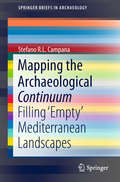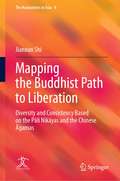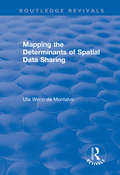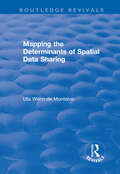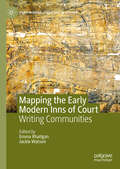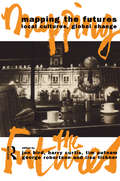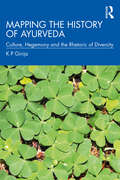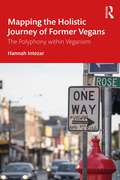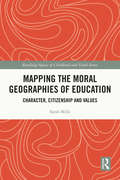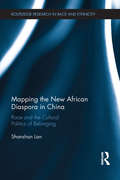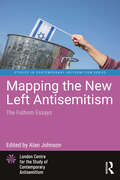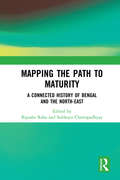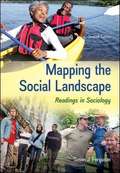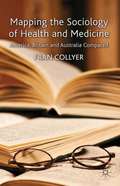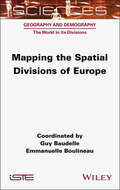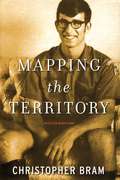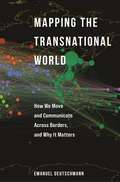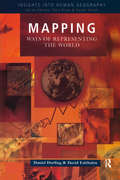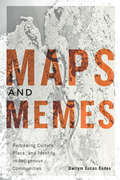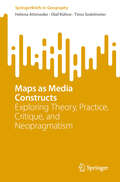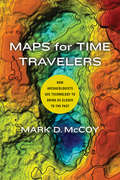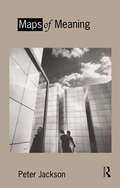- Table View
- List View
Mapping the Archaeological Continuum: Filling 'empty' Mediterranean Landscapes (Springerbriefs In Archaeology Ser.)
by Stefano R.L. CampanaThis book addresses the true 'landscape' perspective approach that archaeologists in Italy, and in many parts of the Mediterranean, use to study the archaeology of landscapes, marking a departure from the traditional site-based approach. The aim of the book is to promote the broader application of new paradigms for landscape analysis, combining traditional approaches with multidisciplinary studies as well as comparatively new techniques such as large-scale geophysical surveying, airborne laser scanning and geo-environmental studies. This approach has yielded tangible and striking results in central Italy, clearly demonstrating that identifying the 'archaeological continuum' is a realistic aim, even under the specific environmental and archaeological conditions of the Mediterranean world.
Mapping the Buddhist Path to Liberation: Diversity and Consistency Based on the Pāli Nikāyas and the Chinese Āgamas (The Humanities in Asia #9)
by Jianxun ShiDue to the diversity in Buddhism, its essence remains a puzzle. This book investigates the Buddhist path to liberation from a practical and critical perspective by searching for patterns found in the Pāli Nikāyas and the Chinese Āgamas. The early discourses depict the Buddhist path as a network of routes leading to the same goal: liberation from suffering. This book summarizes various teachings in three aspects, provides a template theory for systematically presenting the formulas of the sequential training of the path, and analyses the differences and similarities among diverse descriptions of the path in the early Buddhist texts. By offering a comprehensive map of the Buddhist path, this book will appeal to scholars and students of Buddhist studies as well as those practitioners with a serious interest in the Buddhist path.
Mapping the Determinants of Spatial Data Sharing
by Uta Wehn de MontalvoThis title was first published in 2003. With the increasing use of GIS in industrialised and developing countries, the availability of spatial data has become an issue that affects many public and private sector organisations. They are faced with the high cost and substantial effort involved in the generation of spatial data and so the sharing of this data is increasingly being seen as a way of overcoming expense and easing availability and access. But this can provide a way of using GIS effectively only if the key players involved in the use and supply of spatial data are willing to share. This book employs a theory from social psychology as an organising framework to systematize the determinants of organisations' spatial data sharing behaviour. It develops a model which explains the likely willingness of key individuals within organisations to engage in spatial data exchanges across organisational boundaries and then tests this on a survey based in South Africa.
Mapping the Determinants of Spatial Data Sharing (Routledge Revivals)
by Uta Wehn de MontalvoThis title was first published in 2003. With the increasing use of GIS in industrialised and developing countries, the availability of spatial data has become an issue that affects many public and private sector organisations. They are faced with the high cost and substantial effort involved in the generation of spatial data and so the sharing of this data is increasingly being seen as a way of overcoming expense and easing availability and access. But this can provide a way of using GIS effectively only if the key players involved in the use and supply of spatial data are willing to share. This book employs a theory from social psychology as an organising framework to systematize the determinants of organisations' spatial data sharing behaviour. It develops a model which explains the likely willingness of key individuals within organisations to engage in spatial data exchanges across organisational boundaries and then tests this on a survey based in South Africa.
Mapping the Early Modern Inns of Court: Writing Communities (Early Modern Literature in History)
by Emma Rhatigan Jackie WatsonThis collection of essays presents recent research on the Inns of Court and their place in the literature and culture of the early modern world. The volume is structured in three sections. Section One looks at the institutional spaces of the Inns themselves. The chapters consider how the Innsmen&’s identities and writings were shaped by their participation in the communal life of the legal Societies. Section Two looks at the Inns in the context of early modern London. The chapters attend to the intellectual and cultural traffic between the Inns and the city in which they were located by examining the role of Innsmen in the book trade, the circulation of manuscripts, playhouses, and musical culture. Finally, Section Three sets a wider international context. The chapters focus on the role of Innsmen in translation, nation-building, and early colonisation. Together these sections attend to the Innsmen not only as writing communities in themselves, but as participants in a complex of intersecting networks reaching out into London and beyond.
Mapping the Futures: Local Cultures, Global Change (FUTURES: New Perspectives for Cultural Analysis)
by Tim Putnam George Robertson Lisa Tickner Jon Bird Barry CurtisThere are now new experiences of space and time; new tensions between globalism and regionalism, socialism and consumerism, reality and spectacle; new instabilities of value, meaning and identity - a dialectic between past and future. How are we to understand these? Mapping the Futures is the first of a series which brings together cultural theorists from different disciplines to assess the implications of economic, political and social change for intellectual inquiry and cultural practice.
Mapping the History of Ayurveda: Culture, Hegemony and the Rhetoric of Diversity
by K P GirijaThis book looks at the institutionalisation and refashioning of Ayurveda as a robust, literate classical tradition, separated from the assorted, vernacular traditions of healing practices. It focuses on the dominant perspectives and theories of indigenous medicine and various compulsions which led to the codification and standardisation of Ayurveda in modern India. Critically engaging with authoritative scholarship, the book extrapolates from some of these theories, raising significant questions on the study of alternative knowledge practices. By using case studies of the southern Indian state of Kerala – which is known globally for its Ayurveda – it provides an in-depth analysis of local practices and histories. Drawing from interviews of practitioners, archival documents, vernacular texts and rare magazines on Ayurveda and indigenous medicine, it presents a nuanced understanding of the relationships between diverse practices. It highlights the interactions as well as the tensions within them, and the methods adopted to preserve the uniqueness of practices even while sharing elements of healing, herbs and medicine. It also discusses how regulations and standards set by the state have estranged assorted healing practices, created uncertainties and led to the formation of categories like Ayurveda and nattuvaidyam (indigenous medicine/ayurvedas). Lucid and topical, the book will be useful for researchers and people interested in social medicine, history of medicine, Ayurveda, cultural studies, history, indigenous studies, and social anthropology.
Mapping the Holistic Journey of Former Vegans: The Polyphony within Veganism
by Hannah IntezarThis book explores Veganism through the holistic journeys and lived experiences of former vegans, with a particular focus on the impact this has on their Selfhood and identity. It delves into the complexities underpinning definitions of Veganism and vegan identities.Based on original qualitative research charting the experiences of ten former vegans, the text offers a theoretical lens for understanding evolving self-perception, identity, and experience, exploring what leads to initiating a transition in and out of Veganism and how former vegans reconcile with losing their vegan identity. Applying a Bakhtinian model of Selfhood, this book explores the tensions between ‘Voices’ representing values within social discourse, such as Veganism, and how individuals co-construct their identity and self-perception through said Voices. Chapters explore the Polyphony within Veganism and offer an insight into the embodied experience of former vegans. Each analysis chapter has been divided into three distinct Threshold-moments of beginning, middle, and end.Mapping the Holistic Journey of Former Vegans: The Polyphony within Veganism is intended for scholars and postgraduate students interested in Veganism, Selfhood and identity, and behaviour change and anyone looking to understand the context of Veganism in practice.
Mapping the Moral Geographies of Education: Character, Citizenship and Values (Routledge Spaces of Childhood and Youth Series)
by Sarah MillsThis book explores the growth of ‘character education’ in schools and youth organisations over the last decade. It delves into historical and contemporary debates through a geopolitical lens. With a renewed focus on values and virtues such as grit, gumption, perseverance, resilience, generosity, and neighbourliness, this book charts the re-imagining and re-fashioning of a ‘character agenda’ in England and examines its multiscalar geographies. It explores how these moral geographies of education for children and young people have developed over time. Drawing on original research and examples from schools, military and uniformed youth organisations, and the state-led National Citizen Service, the book critically examines the wider implications of the ‘character agenda’ across the UK and beyond. It does so by raising a series of questions about the interconnections between character, citizenship, and values and highlighting how these moral geographies reach far beyond the classroom or campsite. Offering critical insights on the roles of character, citizenship and values in modern education, this book will be of immense value to educationists, teachers and policymakers. It will appeal students and scholars of human geography, sociology, education studies, cultural studies and history.
Mapping the New African Diaspora in China: Race and the Cultural Politics of Belonging (Routledge Research in Race and Ethnicity)
by Shanshan LanWhen one thinks of African diasporas, it is likely that their mind will automatically drift to locations such as Europe and America. But how much is known about the African diaspora in East Asia and, in particular, within China, where race is such a politically sensitive topic? Based on multi-sited ethnographic research in China and Nigeria, Mapping the New African Diaspora in China explores a new wave of African migration to South China in the context of the expansion of Sino/African trade relations and the global circulation of racial knowledge. Indeed, grassroots perspectives of China/Africa trade relations are foregrounded through the examination of daily interactions between Africans and rural-to-urban Chinese migrants in various informal trade spaces in Guangzhou. These Afro-Chinese encounters have the potential to not only help reveal the negotiated process of mutual racial learning, but also to subvert hegemonic discourses such as Sino/African friendship and white supremacy in subtle ways. However, as Lan demonstrates within this enlightening volume, the transformative power of such cross-cultural interactions is severely limited by language barrier, cultural differences, and the Chinese state’s stringent immigration control policies. This book will appeal to scholars and students in the fields of China/Africa relations, race and ethnic studies, globalization and transnational migration, and urban China studies, as well as those from other social science disciplines such as political science, international relations, urban geography, Asian Studies, African studies, sociology, development studies, and cross-cultural communication studies. It may also appeal to policymakers and non-profit organizations involved in providing services and assistance to migrant populations.
Mapping the New Left Antisemitism: The Fathom Essays (Studies in Contemporary Antisemitism)
by Alan JohnsonMapping the New Left Antisemitism: The Fathom Essays provides a comprehensive guide to contemporary Left antisemitism. The rise of a new and largely left-wing form of antisemitism in the era of the Jewish state and the distinction between it and legitimate criticism of Israel are now roiling progressive politics in the West and causing alarming spikes in antisemitic incitement and incidents. Fathom journal has examined these questions relentlessly in the first decade of its existence, earning a reputation for careful textual analysis and cogent advocacy. In this book, the Fathom essays are contextualised by three new contributions: Lesley Klaff provides a map of contemporary antisemitic forms of antizionism, Dave Rich writes on the oft-neglected lived experience of the Jewish victims of contemporary antisemitism and David Hirsh assesses the intellectual history of the left from which both Fathom and his own London Centre for the Study of Contemporary Antisemitism, as well as this book series, have emerged. Topics covered by the contributors include antisemitic antizionism and its underappreciated Soviet roots; the impact of analogies with the Nazis; the rise of antisemitism on the European continent, exploring the hybrid forms emerging from a cross-fertilisation between new left, Christian and Islamist antisemitism; the impact of antizionist activism on higher education; and the bitter debates over the adoption of the oft-misrepresented International Holocaust Remembrance Alliance (IHRA) definition of antisemitism. This work will be of considerable appeal to scholars and activists with an interest in antisemitism, Jewish studies and the politics of Israel.
Mapping the Path to Maturity: A Connected History of Bengal and the North-East
by Bipasha Raha Subhayu ChattopadhyayThis book delves into varied aspects of the history of Bengal and North east situated within a time frame of more than a hundred years, from the colonial times to the present. The individual essays deal with ideas, literary texts, politics, gender, industries, culture, health, sports and tribal issues relevant to these regions. Probing health issues in the colonial period the volume also explains the development of the modern coal industry on the one hand and the survival of the traditional potter’s craft on the other. The significance of traditional healing practices is dwelt upon as also the question of female health and dissemination of knowledge. The pen-picture of the happenings at the bathing ghat reveals the vibrant rural social life of the times. The modernization of the theatre gives a glimpse into the cultural ethos. The institutionalization of sports is examined. Analysis of contemporary cinema throws light on the perception of a woman’s position in society. As the reader travels from Bengal to the North-East, the impact of missionary activities on tribal life is revealed. The tribals’ search for identity is explored. The issues of peace, security and the interests of independent India are also dissected. This volume would be indispensable for scholars of literature, history, film studies, political science and contemporary studies in South Asia. Please note: Taylor & Francis does not sell or distribute the Hardback in India, Pakistan, Nepal, Bhutan, Bangladesh and Sri Lanka
Mapping the Social Landscape: Readings in Sociology
by Susan J. FergusonThis best-selling anthology providesexcellent coverage of key concepts in sociologyincluding culture, socialization, deviance, social structure, social institutions, and social inequality. Drawing from awide selection of classic and contemporary works,the 58 selections represent a plurality of voices and views within sociology. Students will be introduced tocutting edge scholarship and perspectivesthrough classical readings from great thinkers like C. Wright Mills, Karl Marx, Howard Becker, and Max Weber and contemporary articles on current issues like gender socialization, healthcare reform, and minorities in the power elite. By integrating issues of diversity throughout the book,Ferguson helps students see the interrelationships between race-ethnicity, social class, and gender, as well as how these relationships have shaped the experiences of all people in society. Each selection is preceded by a brief introduction that highlights the key sociological concepts for students consider as they read.
Mapping the Sociology of Health and Medicine
by Fran CollyerThis book studies the sociology of health and medicine across three different countries, the USA, UK and Australia, examining the nature of disciplines and their specialties and posing sociological questions about the formation of intellectual fields and their social relations.
Mapping the Spatial Divisions of Europe (ISTE Invoiced)
by Guy Baudelle Emmanuelle BoulineauThe European continent has given rise to the greatest number of spatial divisions. Its limits have provoked numerous debates, both within and outside of the continent. The European Union, for its part, has become a laboratory for the production of divisions. Each of these divisions, a vector of identity and territoriality, reflects an intentionality, as revealed in Mapping the Spatial Divisions of Europe. The book shows the multiplicity of forms and modalities of these divisions and the actors who produce, use and question them in a globalized, and reticular world. From the continent as a whole to the individual regions via metropolitan areas and their networks, from meshing to zoning, from regionalization to representations, this book explores how these divisions are used to govern, plan, imagine and build European territories beyond the heritage of states and their borders. The chapters shed new light on the theoretical and practical issues involved in carving Europe on different time and space scales.
Mapping the Subject: Geographies of Cultural Transformation
by Nigel Thrift Steve PileRejecting static and reductionist understandings of subjectivity, this book asks how people find their place in the world. Mapping the Subject is an inter-disciplinary exploration of subjectivity, which focuses on the importance of space in the constitution of acting, thinking, feeling individuals. The authors develop their arguments through detailed case studies and clear theoretical expositions. Themes discussed are organised into four parts: constructing the subject, sexuality and subjectivity, the limits of identity, and the politics of the subject. There is, here, a commitment to mapping the subject - a subject which is in some ways fluid, in other ways fixed; which is located in constantly unfolding power, knowledge and social relationships. This book is, moreover, about new maps for the subject.
Mapping the Territory: Selected Nonfiction
by Christopher BramNovelist Christopher Bram has been writing essays for twenty-five years. Mapping the Territory, his first collection of nonfiction, ranges through such topics as the power of gay fiction, coming out in the 1970s in Virginia, low-budget filmmaking with friends in New York, and the sexual imagination of Henry James. He describes the heady experience of seeing his novel Gods and Monsters made into an Oscar-winning movie starring Ian McKellen, Brendan Fraser, and Lynn Redgrave; and he discusses why he and his partner of thirty years don't want to get married. Bram looks both into and out of himself in these essays. He revisits the titles he read while finding himself as a gay man, and he also shows us Greenwich Village as seen from his front stoop. The book is not simply a collection of short pieces--it's an autobiography of ideas from one of today's most lively and popular novelists.
Mapping the Transnational World: How We Move and Communicate across Borders, and Why It Matters (Princeton Studies in Global and Comparative Sociology)
by Emanuel DeutschmannA study of the structure, growth, and future of transnational human travel and communicationIncreasingly, people travel and communicate across borders. Yet, we still know little about the overall structure of this transnational world. Is it really a fully globalized world in which everything is linked, as popular catchphrases like “global village” suggest? Through a sweeping comparative analysis of eight types of mobility and communication among countries worldwide—from migration and tourism to Facebook friendships and phone calls—Mapping the Transnational World demonstrates that our behavior is actually regionalized, not globalized.Emanuel Deutschmann shows that transnational activity within world regions is not so much the outcome of political, cultural, or economic factors, but is driven primarily by geographic distance. He explains that the spatial structure of transnational human activity follows a simple mathematical function, the power law, a pattern that also fits the movements of many other animal species on the planet. Moreover, this pattern remained extremely stable during the five decades studied—1960 to 2010. Unveiling proximity-induced regionalism as a major feature of planet-scale networks of transnational human activity, Deutschmann provides a crucial corrective to several fields of research.Revealing why a truly global society is unlikely to emerge, Mapping the Transnational World highlights the essential role of interaction beyond borders on a planet that remains spatially fragmented.
Mapping: Ways of Representing the World (Insights Into Human Geography)
by Daniel Dorling David FairbairnIllustrates how maps tell us as much about the people and the powers which create them, as about the places they show. Presents historical and contemporary evidence of how the human urge to describe, understand and control the world is presented through the medium of mapping, together with the individual and environmental constraints of the creator of the map.
Maps and Memes
by Gwilym Lucas EadesMaps and cartography have long been used in the lands and resources offices of Canada's indigenous communities in support of land claims and traditional-use studies. Exploring alternative conceptualizations of maps and mapmaking, Maps and Memes theorizes the potentially creative and therapeutic uses of maps for indigenous healing from the legacies of residential schools and colonial dispossession. Gwilym Eades proposes that maps are vehicles for what he calls "place-memes" - units of cultural knowledge that are transmitted through time and across space. Focusing on Cree, Inuit, and northwest coast communities, the book explores intergenerational aspects of mapping, landscape art practice, and identity. Through decades of living in and working with indigenous communities, Eades has constructed an ethnographically rich account of mapping and spatial practices across Canada. His extended participation in northern life also informs this theoretically grounded account of journeying on the land for commemoration and community healing. Interweaving narrative accounts of journeys with academic applications for mapping the phenomena of indigenous suicide and suicide clusters, Maps and Memes lays the groundwork for understanding current struggles of indigenous youth to strengthen their identities and foster greater awareness of traditional territory and place.
Maps and Memes: Redrawing Culture, Place, and Identity in Indigenous Communities (McGill-Queen's Indigenous and Northern Studies #76)
by Gwilym Lucas EadesMaps and cartography have long been used in the lands and resources offices of Canada's indigenous communities in support of land claims and traditional-use studies. Exploring alternative conceptualizations of maps and mapmaking, Maps and Memes theorizes the potentially creative and therapeutic uses of maps for indigenous healing from the legacies of residential schools and colonial dispossession. Gwilym Eades proposes that maps are vehicles for what he calls "place-memes" - units of cultural knowledge that are transmitted through time and across space. Focusing on Cree, Inuit, and northwest coast communities, the book explores intergenerational aspects of mapping, landscape art practice, and identity. Through decades of living in and working with indigenous communities, Eades has constructed an ethnographically rich account of mapping and spatial practices across Canada. His extended participation in northern life also informs this theoretically grounded account of journeying on the land for commemoration and community healing. Interweaving narrative accounts of journeys with academic applications for mapping the phenomena of indigenous suicide and suicide clusters, Maps and Memes lays the groundwork for understanding current struggles of indigenous youth to strengthen their identities and foster greater awareness of traditional territory and place.
Maps as Media Constructs: Exploring Theory, Practice, Critique, and Neopragmatism (SpringerBriefs in Geography)
by Olaf Kühne Timo Sedelmeier Helena AttenederThis book fills a gap in the market by taking an introductory look at cartographic representations as multimedia constructs, from theory to critique to neopragmatist perspectives and in practice. It offers an interdisciplinary analysis from the fields of media and communication studies as well as geography and cartography to examine how cartographic representations as constructions of multimedia shape our options for appropriating space and possessing space-generating qualities. Examples from current social discourses such as the COVID-19 pandemic, debates on climate change, and sustainability plus the war in Ukraine show how multimedia cartographic representations are part of the communicative negotiation processes in public media spheres. The book offers insights into the theoretical foundations, historical developments, and practical applications of cartography, with a particular focus on the critical reflection of power structures and interests. It is aimed at students, researchers, and teachers, thereby inviting each to understand maps not only as technical artifacts but also as complex multimedia constructions.
Maps for Time Travelers: How Archaeologists Use Technology to Bring Us Closer to the Past
by Mark D. McCoyPopular culture is rife with movies, books, and television shows that address our collective curiosity about what the world was like long ago. From historical dramas to science fiction tales of time travel, audiences love stories that reimagine the world before our time. But what if there were a field that, through the advancements in technology, could bring us closer to the past than ever before? Written by a preeminent expert in geospatial archaeology, Maps for Time Travelers is a guide to how technology is revolutionizing the way archaeologists study and reconstruct humanity’s distant past. From satellite imagery to 3D modeling, today archaeologists are answering questions about human history that could previously only be imagined. As archaeologists create a better and more complete picture of the past, they sometimes find that truth is stranger than fiction.
Maps of Meaning: An Introduction To Cultural Geography (Contours Ser. #Vol. 1)
by Peter JacksonThis innovative book marks a significant departure from tradition anlayses of the evolution of cultural landscapes and the interpretation of past environments. Maps of Meaning proposes a new agenda for cultural geography, one set squarely in the context of contemporary social and cultural theory. Notions of place and space are explored through the study of elite and popular cultures, gender and sexuality, race, language and ideology. Questioning the ways in which we invest the world with meaning, the book is an introduction to both culture's geographies and the geography of culture.
